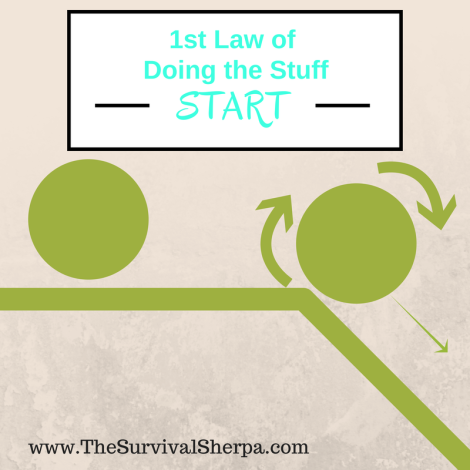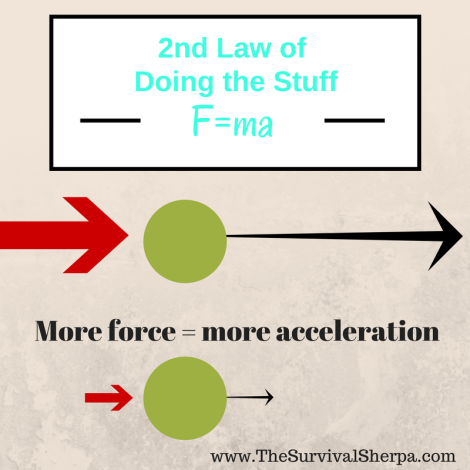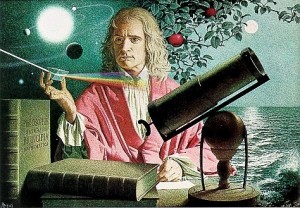Scientists use applied physics to find solutions to real world problems. These smart people put principles of physics to work to add value to our everyday lives. They trade theory for action!
In one of the most monumental scientific books ever written, Sir Isaac Newton painted a different picture of how the world works. His three simple laws of motion transformed the scientific community and set in motion a revolution in math and science.
Have you ever thought about applying the 3 laws of motion to improve your life, skill sets, and self-reliance?
If not, follow along as we go back to science class to explore, without boring lectures and calculus, the physics of Doing the Stuff of self-reliance.
“Self-reliance is the only road to true freedom, and being one’s own person is its ultimate reward.”
~ Patricia Sampson
Newton’s big idea became law after many people verified his theory with action. Here’s a simplified version of his Laws of Motion and how to apply them on your climb to self-reliance and preparedness. Keep in mind that each of these laws builds upon the previous law.
The 1st Law of Doing the Stuff
Newton’s first law of motion simplified…
Objects tend to keep doing the stuff they are doing, resting or moving, until some other force is applied to them.
Your level of self-reliance will not change without an unbalanced force being applied. Your lack of motion will not change unless something happens to you. Your life and skill set will stay the same.

The flip side of this law is also true!
If you’re already in motion Doing the Stuff, you tend to continue in that direction. Once you start doing the stuff of self-reliance, momentum builds. The act of doing is the force needed to break the dam of dependence we all float in at times.
The first law of Doing the Stuff is to start. I put together 13 Preps You Can Do in 120 Seconds or Less to help you get moving. You’ll also find several self-reliance projects to try on the DIY Projects tab at the top of this page. Once the ball is rolling, it’s easier to keep it moving.
Self-reliance is a climb with many small steps. You may be putting off one or two skills you’ve always wanted to learn. Owning the skill will never happen until you take the first step of starting.
For instance, I was reluctant to start crafting leather. There was a 40 year stretch between my first leather project and my new leather creations. I’m no professional but, by starting, I’ve learned to make functional stuff from raw material with my own hands. That alone is reward enough for me.
By far, the biggest mistake I’ve made on my journey to self-reliance is failure to launch. Not starting a new skill, for whatever reason, effects zero motion. Overcome inertia with small starts.
Get this out of your mind. You don’t have to master the skill. But you must start! I would argue that combining many self-reliant skills trumps expertise in only one specialized area. Robert Heinlein said it best, “Specialization is for insects.”
Start doing as much as you can as much as you can!
The 2nd Law of Doing the Stuff
Newton’s second law of motion simplified…
When a force acts on an object, it will cause the object to accelerate.
Obvious, right?
A simple equation sums up the second law of Doing the Stuff:
F=ma (Force equals mass times acceleration)

The more force applied to an object, the more it accelerates. This implies that working hard (applying force) will accelerate your skills.
Not so fast, speedy!
Force is a vector.
What’s a vector?
You can’t hold a vector. It’s not tangible. Simply put, it’s a number value. Vectors add both direction (focus point of the force) and magnitude(size of force) to the 2nd Law of Doing the Stuff.
The entire concept of accelerating your skills depends on where you apply force and the size of the force. Acceleration has direction. Speed does not. To accelerate your Doing the Stuff skills, it’s important to understand that acceleration is any change in an objects speed ordirection.
To get an object (you) moving in a direction of self-reliance, focused force must be applied in that direction. The size of your force depends on the mass of the object (simple or complex skill) you want to move forward. Grabbing yourself by the bootstraps and hard work alone won’t get you there. You need force applied in a specific direction.
Here’s the thing…
You only have x amount of force available. It’s a limited resource which needs to be conserved – just like calories in a survival situation.Where you apply force is more important than how hard you work to hone your skills.
For instance, anyone who practices primitive fire craft understands the importance of direction and magnitude of force. Learning the nuances of friction fire methods takes practice and properly prepped material. Even then, all you’ll get is smoke and a sweaty shirt until you apply the proper amount of force at the correct angle. You can’t know that until you’ve created a primal ember.

But once the ember is born, you’ll be in a state of euphoria staring at its glow!
The 3rd Law of Doing the Stuff
Newton’s 3rd Law of Motion simplified…
When one object exerts a force on an other object, the second object exerts and equal and opposite force back.
The chair you’re sitting on exerts an upward force equal to the downward force of your butt. If the size of the downward force exceeds the upward force, the furniture fails. In this example, you want equilibrium.
Forces come in pairs. If forces are symmetrical (equal), balance is achieved. No movement, forward or backward. The object is at rest and will remain at rest. Forever. See Law #1.
However, to move your Doing the Stuff skills along, you must create an unbalanced state. Controlled. Reproducible. Consistent.

The Battle of Forces
There are two options to create motion (unbalanced state) in the battle of forces:
- Increase the magnitude (size) of one force against an opposite force
- Decrease or eliminate an opposite force
As mentioned in Law #2, force is limited. Option 1 is unsustainable for long-term self-reliance. You can only pump yourself up for so long before reaching exhaustion. Caffeine induced bursts of energy and hard work are necessary at times (and I partake in both), but eventually you body runs out of force.
The sustainable choice to build skills is to take a deuce. Eliminate and flush unproductive forces.
To illustrate, apply physics to your 72 hour kit or bug out bag. If your reduced to foot travel, the latest shiny survival stuff only adds mass on your back. Are these shiny objects even necessary to effect your survivability? Probably not!
With proper skills and essential tools, you increase skill set acceleration with the same amount of force. F=ma. The older I get, the more I realize the need to simplify life and remove opposing forces.
Less stuff x skills = self-reliance
Keep Doing the Stuff of Self-Reliance,
Todd

